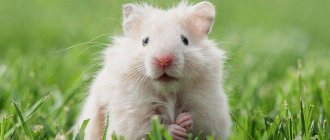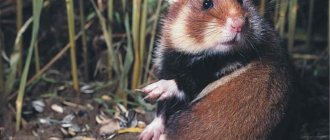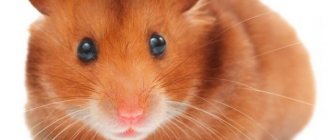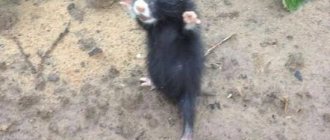The appearance of wild hamsters in a garden or summer cottage brings a lot of trouble to their owners. Unlike domestic furry pets, which cannot eat a lot of things, a wild hamster is omnivorous and is capable of destroying fruits, vegetables, root crops and grain crops in the countryside.
Owners of household plots, in order to protect and preserve their crops, must know the basic rules for dealing with hamsters, which cause a lot of trouble.
Before you start breeding animals, you need to remember that their mucous membrane is a breeding ground for numerous infections (more than thirty species). When you start hunting for hamsters, you first need to think about protecting your hands from bites and how to kill a hamster without harming your own health.
The main difference between wild species and domesticated individuals is the tricolor color of the coat. They can also be distinguished due to the physiological characteristics of animals - the appearance of cheek pouches intended for transporting food, the reserves of which they constantly replenish.
The main reason why you need to get rid of hamsters is that even though these animals are loners, if a nourishing place is found, their relatives will immediately find out about it. Also, the wild species of rodents is quite prolific. In a year, one female can give birth to up to three litters (this is about forty babies), which in two months will independently reproduce and in the warm season can quickly populate vast territories and destroy almost everything that can be eaten.
Conservation status and distribution
A wild hamster in the country (Karbysh is a type of rodent that causes great harm to agriculture) is one of the main dangers for farmers and agricultural enthusiasts. This forest animal, with a bright color, reaching a length of 40 cm and a weight of 800 g, a light brown coat, a black belly and brown beady eyes, looks like a completely harmless and cute creature, very reminiscent of pets. The animal has blond hair on the tips of its ears and muzzle.
The same stripes run along the entire length of the hamster's back. There are whiskers near the animal's nose, and a long tail ends the body. Like other hamsters, the distinctive feature of the animal is its large cheek pouches, designed for carrying prey. The forest hamster lives throughout Europe and China in the mountains, steppes and on the coasts of reservoirs. To dig holes reaching a width of 8 m and a depth of 1.5 m, Karbysh prefers to choose loose soil.
He especially likes the fertile soil of vegetable gardens and summer cottages, which at the same time provides not only comfortable housing, but also abundant food.
The wild hamster Karbysh, despite the harm caused by the summer cottage, is considered one of the rare animals and has a conservation status in the Belgorod, Voronezh, Leningrad and Lipetsk regions. In these zones, any inhumane methods of rodent control are strictly prohibited, with the exception of the presence of cats or dogs on the site that can scare away or destroy the harmful animal.
The wild hamster Karbysh, despite the damage caused to summer cottages, is considered one of the rare animals and has a conservation status in the Belgorod, Voronezh, Leningrad and Lipetsk regions. In these zones, any inhumane methods of rodent control are strictly prohibited, with the exception of the presence of cats or dogs on the site that can scare away or destroy the harmful animal.
Karbysh hole
A gardener whose garden this pest has wandered into needs to know how to deal with carbysh. But the rodent spends most of its time in the hole. Therefore, it is necessary to arm yourself with knowledge of how it works.
The common hamster does not always dig housing itself; sometimes it takes it away from other relatively large rodents, for example gophers. The karbysh's burrow is always deep (about 1.5 m), with a complex system of tunnels (about 8 m long). There are at least 2 entrances (usually about 5), but sometimes up to 10, a nesting room, as well as many storage rooms.
Signs of hamsters appearing in a summer cottage
A wild hamster in the country (Karbysh has a very cute appearance, but is quite large for a rodent) is capable of destroying not only the crop, but also all the supplies hidden deep in the cellars, as well as damaging the bark of trees. During the day, the animal hides in its hole, and at night it comes to the surface in search of food, so it is quite difficult for it to meet a person.
You can determine that a small rodent has settled in your dacha by a number of signs:
- The appearance of a large number of holes and tunnels from them. Large and wide holes should be of concern, since the hamster’s home is at least 10 cm larger than that of a mole or shrew. When you try to dig an underground passage in such a hole, you can find a large supply of grain and other food, reaching in some cases up to 90 kg.
- Gnawed bark from large trees located near a rodent burrow.
- The presence of hamster excrement appearing in places where it eats.
- Undercuts appearing in the beds of carrots and potatoes, located right at the roots of the vegetables.
Since one hamster needs at least 700 g of food per day, and the rodent population is multiplying at a record speed, summer residents need to find Karbysh’s habitat as early as possible. Otherwise, the forest hamster will quickly destroy not only the ripening crop, but also the plants themselves.
Lifestyle
These animals are most ; during the day they hide in a hole. In winter, it hibernates, but not deeply, and periodically wakes up to eat from its reserves.
Comes out in March - April. Males are friendly only to females during the breeding season, the rest of the time they are aggressive towards everyone, including humans .
The size of the enemy is not important for a hamster . They have a solitary lifestyle and protect their territory. They attack “unwanted guests.”
Damage to the garden
Despite its small stature and rather harmless appearance, at first glance the forest hamster is very voracious. The daily diet of an adult hamster is about 700 g. In addition, the rodent is very thrifty, storing in its hole a large amount of grain and other food that it needs for proper winter hibernation.
In addition to the daily food and supplies that hamsters make in their home, Karbysh multiplies very quickly, turning garden plantings into a completely deserted area. Hamsters give birth to babies in the spring, but if the weather is favorable, a fertile female is capable of giving birth to 3-4 litters per year, each of which will contain 8-16 babies. Born blind, babies grow and mature quite quickly, turning into full-fledged hamsters.
A wild hamster, Karbysh, in the countryside can cause a lot of problems. Rodents are very voracious.
Since one male is capable of fertilizing several females at once, and the lifespan of one hamster reaches 4 years, the population of animals within one summer cottage grows exponentially, completely destroying not only the harvest and roots of adult plants, but also those that have just hatched from under earth sprouts.
Forest hamsters go into hibernation at the end of October, and wake up with the first thaw in April, when they go looking for tomato, cucumber or flower seedlings in search of food.
With their teeth, they cut off the plant like a razor, preventing it from growing further, and also make their way into cellars and basements located at a depth of 1.5-2 m, where they spoil supplies of vegetables and grain. In addition to destroying root crops, hamsters also drag soil into basements, polluting them and causing inconvenience to the owners.
What kind of animal is this
To understand how to deal with carbysh in the garden, you first need to know what it is.
In fact, this is the colloquial name for the common hamster. Presumably the word “karbysh” was borrowed from Turkic languages. An adult male reaches an average size of 31 cm and weighs about 700 g. The muzzle is elongated, the ears are round, rather short, covered with dark hairs. The tail is thick at the base with hard hairs, gradually becoming thinner towards the end. The paws are short and end in long claws. As befits a hamster, it has cheek pouches for carrying food.
The skin is striking, multi-colored: plain on top, red or brown, light sides, black belly. There are completely black individuals. These are the ones that predominate in Russia.
Leads a nocturnal lifestyle. This is a very agile, cautious and at the same time capable of fighting back animal. All this does not make it easier to fight him, quite the contrary. These rodents are quite aggressive. If the animal is not left with an escape route, it is likely to attack a person.
A female gives birth to about a dozen cubs per season, so if you do not drive away the carbysh, in a few years there will be much more of them, which means that the damage will also increase many times over. You can’t just “wait them out.”
Humane ways to control rodents
A wild hamster in the country (Karbysh is considered a nomadic animal that has no particular affinity for its hole and is able to move to where the food source will be) in a few days it is capable of destroying an entire bed of potatoes or carrots, thereby providing itself with food for a long time. The enormous damage caused to agriculture has become one of the main reasons for the total extermination of hamsters.
Most control methods are based on the destruction of the rodent's home or the appearance of a danger association associated with the burrow, forcing the hamsters to leave the selected territory. This method is a humane method of rodent control and does not exclude the possibility of the hamster returning to the garden in the future. This is especially likely if large reserves of grain remain in the hole, in some cases reaching 16-90 kg.
Other humane methods of dealing with a hamster include catching it and transporting it to a safe place away from the garden. In this case, Karbysh’s burrows are first flooded with water, and when he runs out, he is caught, placed in a carrier and taken to the forest or field.
Despite the humaneness of the method, it is accompanied by a high risk of danger, since an aggressive hamster is capable of severely biting a person. That is why it is forbidden to catch a hamster with your bare hands or use a net for this purpose. In addition to water, you can drive Karbysh out of the hole using smoke.
Traps and snares
A wild hamster in the country (Karbysh is a rather aggressive animal, always ready to repel the enemy) is a real disaster for gardeners, requiring the urgent use of mechanized deterrents or the installation of traps. In this capacity it can act as a homemade mechanical device installed at the entrance to a hole or a special hunting trap.
The main condition for such a design is its large size and the mandatory presence of fastening, since due to its volume, Karbysh is able to simply turn the trap over and easily get out. A large rat trap secured with a peg is also suitable as a trap.
There are a huge number of options for making a hamster trap, but the simplest and most effective is the installation of a large box with a tight-fitting lid, to which 2 rubber bands are attached. A spacer is installed at the bottom of the box, holding the lid of the trap, and the bait is placed inside the box. Attracted by the bait, the rodent runs into the trap, simultaneously disturbing the balance of the thrust, which instantly slams the lid of the box.
A hamster caught in this way must be taken out of the garden as far as possible and released into a forest or field.
How to get rid
Do you have carbysh on your property? How to fight? Photos and descriptions of traps, as well as special means, will be presented below.
Everyone knows the old-fashioned way to drive moles out of the garden - fill the holes with water. This method is also suitable for combating carbysh. There are several nuances. Firstly, you will need a lot of water, because the karbysh’s hole, as already mentioned, is always deep and with an extensive network of corridors. The second point is that the hamster's tunnel system, as a rule, has several exits, so it is necessary to close everything except the one into which water is poured. Then you just have to wait until the rodent begins to choke and gets to the surface.
Ultrasonic repellers
Ultrasonic repellers are considered one of the humane ways to combat wild hamsters. Installed on a summer cottage, they do not kill the animal, but only emit ultrasonic waves of various frequencies, which are not perceived by humans, but are very unpleasant for rodents. Repellers that constantly act on the ears of the hamster force the animal to leave its habitat, thereby protecting the plantings and future harvest.
The most popular models of ultrasonic repellers are:
- “Electrocat” - in addition to ultrasound, it also produces light flashes that greatly frighten rodents.
- "Grad" is a repeller with ultrasonic and sound waves, and also has the effect of a flickering light beam.
- "Typhoon". Having a coverage area of more than 200 m, it is able to work in both sound and silent modes, reliably repelling small rodents.
Some gardeners prefer not to install on the surface, but to bury ultrasonic repellers in the ground, but this method does not always give a good result, since in this situation the repellers have a greater effect on moles and mice, but have practically no effect on Karbysh.
Inhumane methods of rodent control
In addition to humane methods, inhumane methods of rodent control are also especially popular, based on the use of various poisons, as well as folk remedies, mixed into bait and severely injuring animals.
Poisons
A special poison for rodents, based on the action of a potent poison, can be purchased at any store selling agricultural products. Such poison, placed in burrows or installed in a special container as bait at the entrance, is given to the rodent to eat, which falls ill within a few hours and slowly dies.
The bait needs to be updated periodically. It is also important to ensure that near the burrow there are no reservoirs of water accessible to the hamster, which can quickly cleanse the animal’s body of strong poison.
Available for sale:
| A drug | Description |
| Warat | Grain-based granules containing brodifacoum lead to the death of a rodent within 4-10 days from the moment of consumption. A distinctive feature is also the low cost of the product. |
| Clerat | A strong rodenticide containing bodyfacoum and bait that can kill a hamster within 3-7 days from a single dose. |
| Storm | Wax briquettes with flocumafen are among the most active toxic substances, based not only on the action of the toxin, but also on the ability of paraffin to block the stomach’s ability to digest food. The rodenticide contributes to the death of the rodent after 4-5 days, but is also quite toxic to humans, and therefore requires precautions when used. |
| MB final | The drug is in the form of a paste that enters the hamster’s body and causes death within 5-7 days. |
| Rat death | Soft briquettes based on bodyfacoum, which, when ingested, impair blood clotting and cause internal bleeding, leading to the death of the animal. Death from poison occurs within 4-8 days. The drug is suitable for use on all types of rodents. |
Traditional methods of fighting rodents
In addition to special poisons, there are also “folk” methods for producing toxic substances:
- Quicklime mixed with sugar, when it gets into an animal's burrows, like ash, contaminates its skin, forcing it to actively lick itself. Unlike ash, which causes pain, lime causes a severe burn of the esophagus, leading to death within 15 minutes.
- Wheat flour and alabaster . A similar mixture based on construction powder is also poured into the animal’s hole or placed in a bowl and placed at the entrance. A prerequisite in this case is to place a bowl of water next to it, since after eating the bait, the hamster will certainly want to drink, and the alabaster in the stomach that comes into contact with water will gradually thicken, provoking the death of the animal.
- Ash. The ash that gets into the burrow does not in itself kill the hamster, but simply contaminates its skin, forcing it to lick itself as often as possible. Pieces of ash that enter the animal's esophagus cause it severe pain and force it to associate its home with potential danger, requiring an urgent search for another habitat.
Crushed wine cork. Any wine cork (except plastic) needs to be crushed and carefully mixed with bread. After watering the bait with vegetable oil, it should be left at the entrance to the hole, additionally placing a saucer of water next to it. The hamster that eats the “treat” will die within 1 hour because the plug will gradually swell and rupture the stomach.
A more humane method of dealing with a hamster is to bury an alarm clock in the ground. Battery-powered alarm clocks placed in metal buckets or glass jars should be buried around the entire perimeter of the site. Buckets, like jars, must first be closed with lids and then installed at a greater depth. The only drawback of this method is the difficulty in replacing batteries, since alarm clocks must ring continuously, greatly irritating the animal.
Hamster danger
The wild hamster Karbysh is often mistaken by the owners of their summer cottage for a harmless animal that is easy to pick up and place in a cage. However, experts do not advise underestimating the animal, since, despite its appearance, Karbysh has a very ferocious disposition. In addition to the complete destruction of crops and plants on the site, a hamster can pose a danger to both domestic animals and humans.
Unlike other rodents that run away when danger approaches, Karbysh stands up, stretches out to his full height, puffs out his cheeks, squeaks threateningly, grinds his teeth and pounces on the enemy, trying to bite him as hard as possible. Lacerations and bites left by a hamster are painful and can cause a lot of discomfort.
Wood hamsters are considered carriers of 30 types of infectious diseases that can cause not only long-term illness, but also death.
Caution must also be observed when catching hamsters, both for the purpose of transporting them and when they fall into traps. In its behavioral habits, Karbysh strongly resembles a rat, which, when caught in a trap, gnaws off its own paw in order to get out. A freed, wounded animal is capable of attacking a person or pet, leaving a lacerated wound.
In this case, the bite site must be immediately rinsed with running water and disinfected with hydrogen peroxide, a solution of brilliant green or iodine. If the bitten hamster was a carrier of infection, by the evening after the bite the victim should have a fever, difficulty breathing, or general weakness. In this case, you should immediately call an ambulance, since delay can cause death.
Can it be kept at home?
We should not forget that this is a wild animal that can show aggression and bite a person. The bite of a wild hamster can cause up to 30 different diseases, and in the absence of timely measures taken, death. In this regard, it is not worth keeping a rodent in captivity. Many are also interested in: “How to tame a field hamster?” It's not worth even trying. Karbysh cannot be tamed, even if caught as a cub. It is much easier and safer to buy a hamster at a pet store.
Sources used:
- https://rusfermer.net/ogorod/vrediteli/dikij-homyak.html
- https://superda4nik.ru/kak-izbavitsya-ot-xomyakov-na-dache/
- https://rusfermer.net/ogorod/vrediteli/dikij-homyak.html
- https://superda4nik.ru/kak-izbavitsya-ot-xomyakov-na-dache/
- https://rusfermer.net/ogorod/vrediteli/dikij-homyak.html
- https://slonvkvartire.ru/homyaki/kak-pojmat-i-izbavitsya.html
- https://rusfermer.net/ogorod/vrediteli/dikij-homyak.html
- https://mycountry.house/2019/kak-izbavitsya-ot-homyakov-na-dachnom-uchastke.html
- https://rusfermer.net/ogorod/vrediteli/dikij-homyak.html
- https://tvoihomiak.ru/obshchiye-svedeniya/kak-borotsya-s-dikimi-homyakami.html
- https://rusfermer.net/ogorod/vrediteli/dikij-homyak.html
- https://homiakam.ru/vidy-xomyakov/polevoj-xomyak-i-vse-o-nem.html
- https://animallittle.ru/dikij-homjak.html
- https://animallittle.ru/dikij-homjak.html
Natural enemies of the hamster
A wild hamster in the country is very afraid of domestic animals, including cats and large dogs. The appearance of these pets is considered reliable protection against all types of rodents. However, despite the fear of domestic animals, Karbysh, unlike ordinary rodents, is able not only to hide, but also to repel enemies. Due to its large size and dangerous teeth, Karbysh is capable of seriously injuring a cat, Chow Chow dog, York Terrier or Chihuahua.
Only medium-sized or large-sized dogs, as well as fighting breeds, can cope with it, but even here you should be wary of lacerations and possible infection. Cats, unlike dogs, are more skilled at catching rodents, but even here they can get unplanned injuries that require a visit to the veterinary clinic.
Knowing this feature of Karbysh, you should be wary of ordinary pets, especially since among them there are pets who are completely unaccustomed to catching rodents, and entrust the fight against the hamster to specially trained dogs. The presence of a cat or dog at the dacha is also a fairly good prevention against the appearance of Karbysh, since the smell of pets alone forces hamsters to leave their holes.
The wild hamster Karbysh is a real “thunderstorm” of summer cottages, capable of destroying plantings, harvested crops and even seedlings just beginning to grow. Consuming large amounts of food and extremely thrifty, the rodent reproduces at a record speed, almost completely destroying the work of gardeners, and due to its aggressive nature it can cause lacerations or dangerous infections.
Cats and dogs can cope with rodents that move at night. Also, good results in catching it are obtained by a variety of traps and snares or poisonous, albeit inhumane, chemicals.
Reproduction
The common hamster has no social organization. The animal adheres to a solitary lifestyle and is very aggressive towards other representatives of its species. So, for example, if he meets another karbysh, he may start a fight. They form a pair only for a short mating period, which begins in March.
From March to August, the female bears up to 5 litters, each of which usually contains from 4 to 12 cubs. After just two months, the cubs become adults and begin to live separately. So if you don’t think about how to get rid of the pest, the hamster will multiply and become an even greater threat to the plantings.











